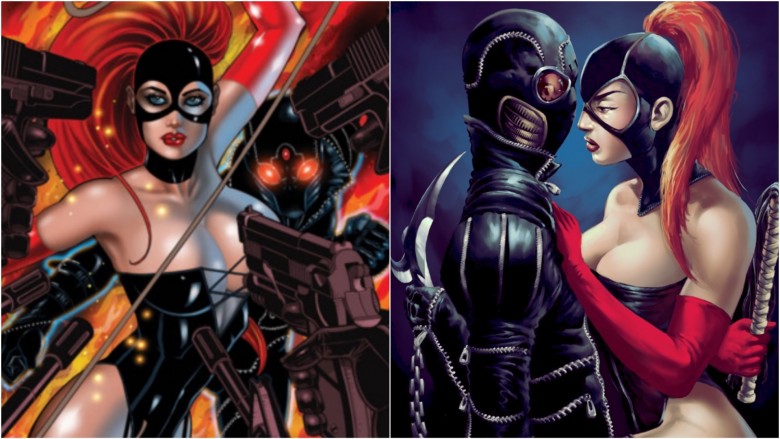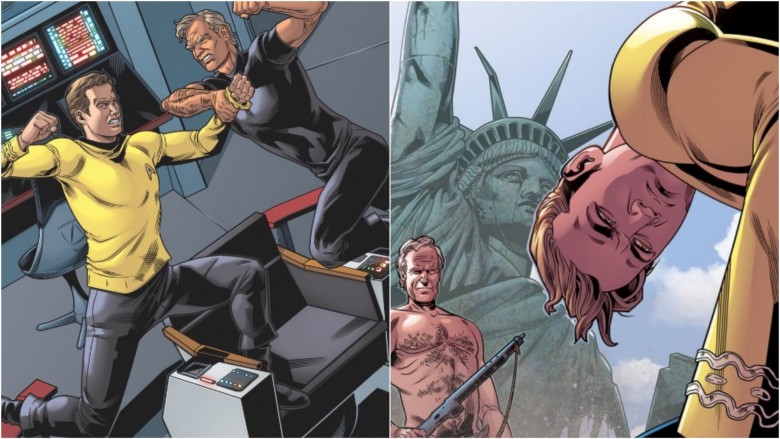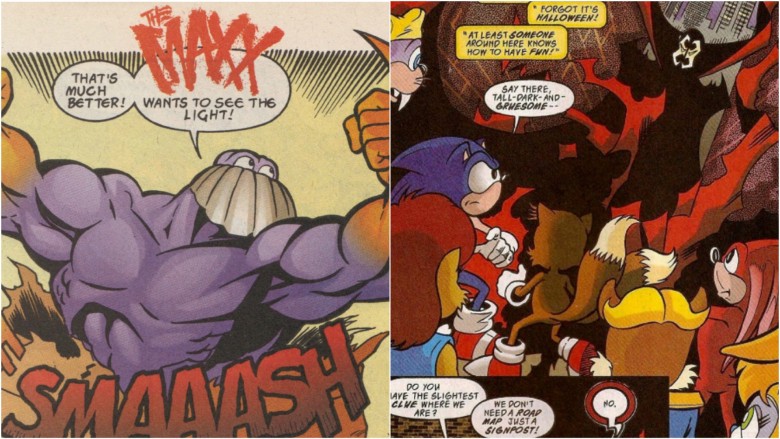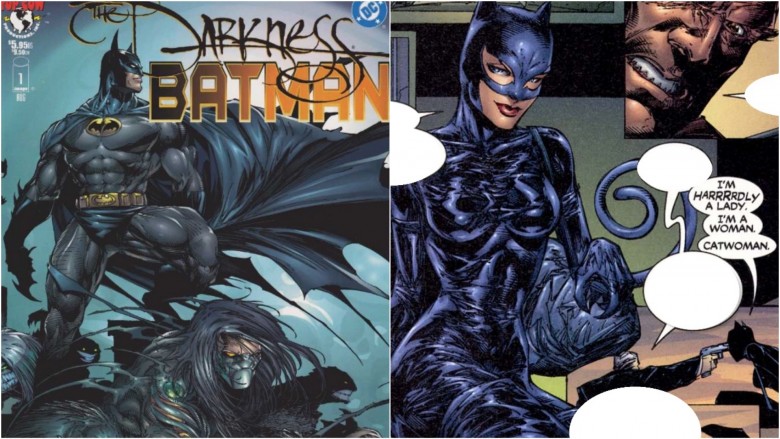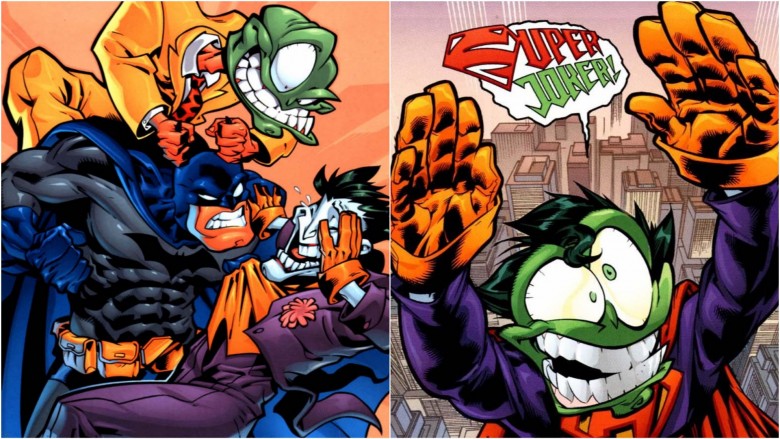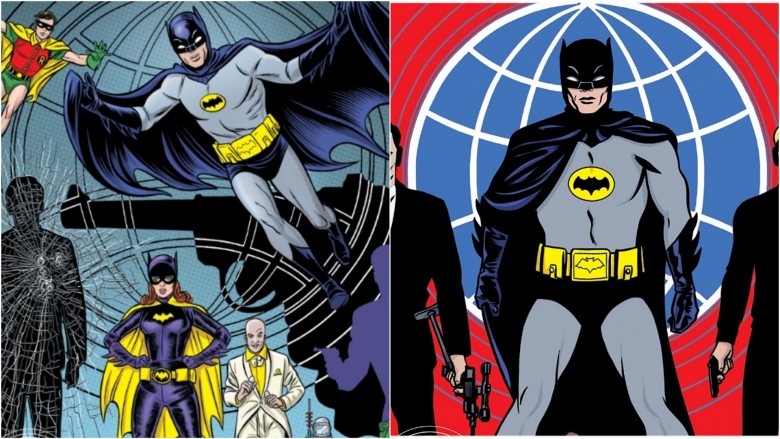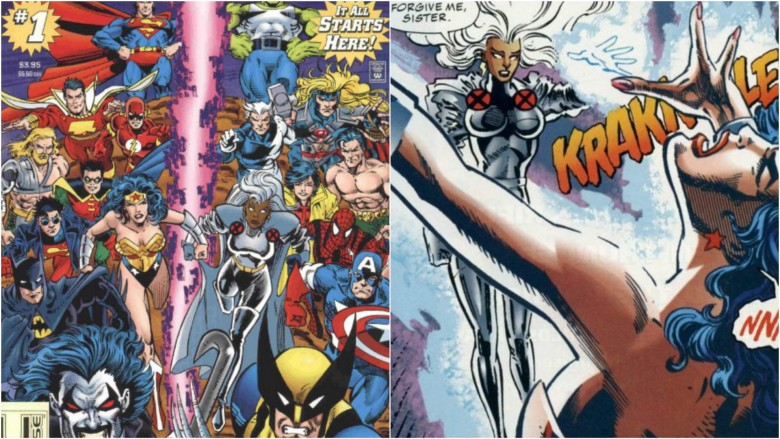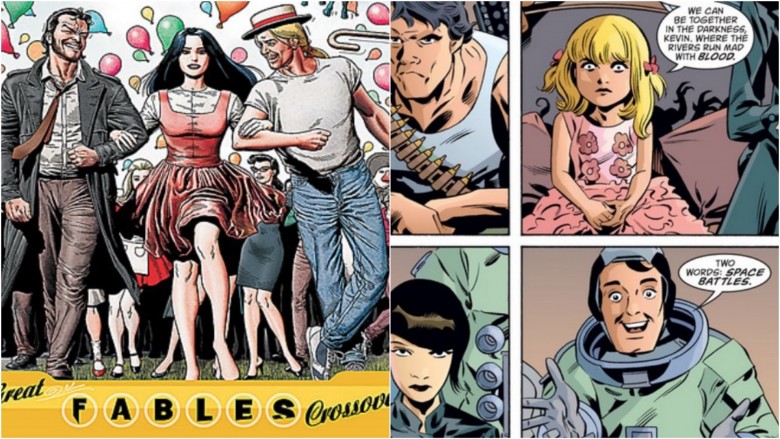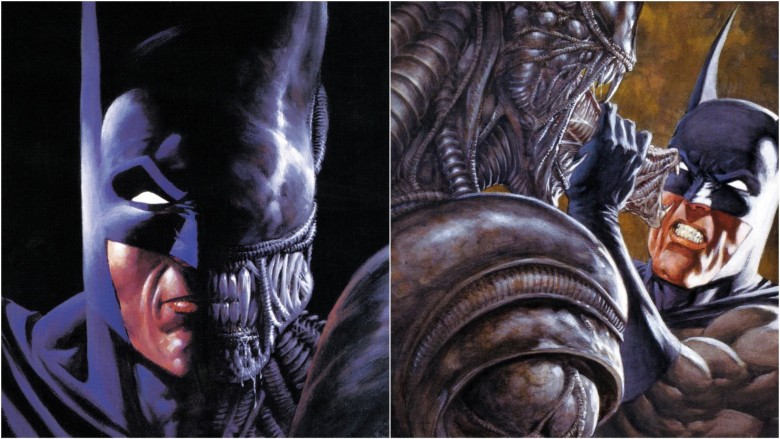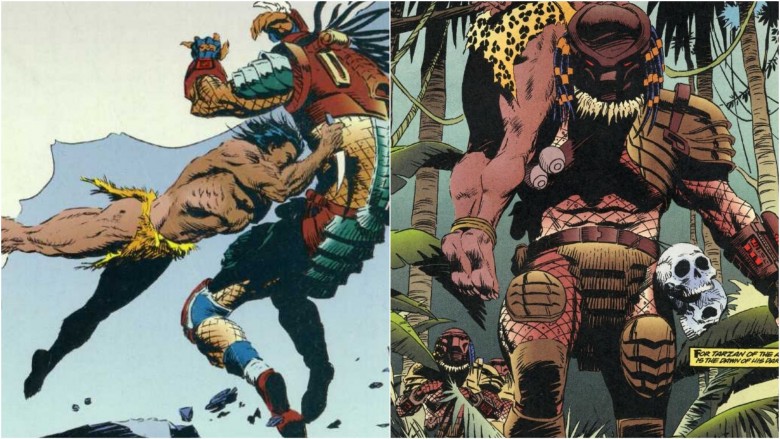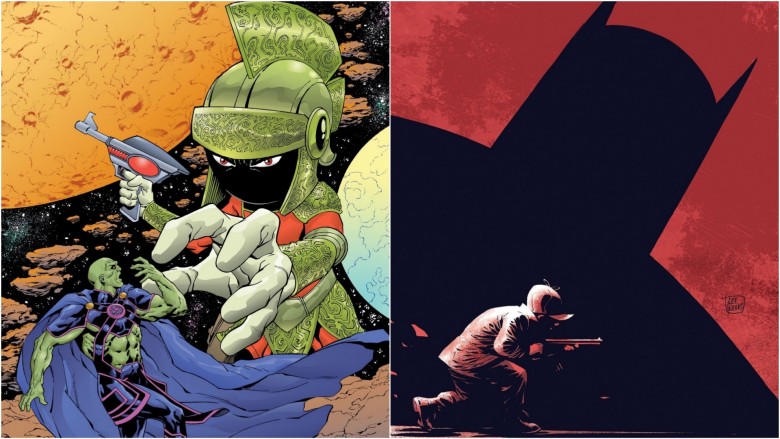Insane Comic Book Crossovers That Never Should've Happened
It's impossible to please all comics fans all the time. A successful crossover starts with two or more franchises, writers, artists, creative teams, and publishers, crosses that volatile solution with two or more cranky fanbases, and produces a miracle of market-friendly, brand-expanding, crowd-pleasing alchemy. Usually, though? Great tastes just taste weird together. Here are some of the worst flavor combinations comics have to offer.
Spoilers ahead.
Zipper vs. Dominatrix
Two unexpected heroes in fetish gear join forces to bring down generic gangsters and their sex slavery operation. That's the premise of the Arcana-Simmons Comics Group crossover event Zipper Vs. Dominatrix: The Slave Trade, written by Erik Hendrix (The Steam Engines of Oz, SideShows) with art by Yannis Roumboulias.
Gene Simmons of KISS is credited with creating both Dominique Stern, A.K.A. Dominatrix, a magic pill-popping, fetish industry sex worker who also fights crime ("CIA meets T&A," as Simmons himself puts it), and Xeng Ral, A.K.A. Zipper, a space alien in a custom-built exo-suit which happens to resemble a full-body latex catsuit. Despite the "Vs." in the title, it's more or less a teamup.
Why doesn't it work? It's two underdeveloped one-note heroes fighting one-note villains. A Catwoman ripoff that forgets pretty much everything that makes Selina Kyle fun and interesting, Dominique Stern can't decide whether she wants to earnestly represent the kink community with explanations of consent ("In my line of work... it's all choices. I can say no, they can say no," she says in narration) or be a wisecracking, vindictive cold-blooded killer who feels "empowered" as she uses her whip to strangle an assailant.
Meanwhile, Zipper is yet another humorless generic space alien. The gimp suit joke gets old quick. Zipper's dark-skinned comic relief sidekick, Ronnie J., is stereotypically "urban," saying "dis" instead of "this," and making lewd comments about women. Faced with what looks like certain death, he laments not "going out" the way he hoped he would: "spliff in hand" while having sex with a "girl." Never mind how traumatizing such an experience would be for her...
Star Trek and Planet of the Apes: The Primate Directive
Written by Scott and David Tipton, and faithfully illustrated by Rachael Stott, IDW and Boom! Studios' uneven Star Trek and Planet of the Apes crossover The Primate Directive is certainly better than it could have been. But the same can be said of Generations, Insurrection, and Battle for the Planet of the Apes.
On the Trek side, it starts out great, with Lieutenant Nyota Uhura and Mr. Hikaru Sulu infiltrating a Klingon communications post undercover, securing the intel, and fighting their way out. According to the intel, the Klingons may be using a mysterious portal to travel between dimensions and stockpile advanced weaponry in violation of the Treaty of Organa. The technology that powers the portal is so highly advanced that Mr. Spock doesn't know what to make of it. Dr. Leonard "Bones" McCoy worries that, if they cross the interdimensional rift, they won't be able to get back. Concerned about the imperial machinations of the Klingons, Captain James T. Kirk insists on flying through the portal to investigate. Guided by the Prime Directive, which forbids knowing interference with the evolutionary progress of alien civilizations, Starfleet forges into the unknown.
The Starship Enterprise breaks on through to the other side of the incursion, and ahead of the ship lies a future Earth of another universe. Spock speculates that, at some point, nuclear war almost eradicated human life on the planet. The crew lands on the planet, meets up George Taylor, learns of the Apes' oppressive regime and humans' livestock status. Taylor learns that the Prime Directive prevents Starfleet from providing assistance to the human-led rebellion, and so he steals a Communicator. Later, Scotty—being Scotty—says too much, revealing to the Apes how spaceships work. (This will have serious consequences.)
There isn't quite enough content here for a five-issue series. If the Klingons have interfered with the civilization's development—and if the "alien" civilization is indeed human civilization—how does the Prime Directive apply? What starts as an okay comic starts to get tedious around the third issue, devolving into an uninspired, anti-climactic fistfight/bonding experience between Taylor and Kirk aboard the Enterprise. The explosive finale should be tragic but it's played for laughs, with the Earth exploding violently, and Kirk wondering whether Starfleet was to blame. Stranded in space, Ape-astronauts (Thanks, Scotty!) plan to make use of the Slingshot Effect, the most illogical part of the 1966 series and "the movie with the whales," to time-travel.
Crossing the most optimistic spacefaring series with such a grim, fatalistic, antinuclear franchise does each a disservice. Worse yet, before Starfleet have set foot on Earth's soil, Spock tells Kirk that readings indicate this is Earth post-nuclear annihilation on an alternate timeline in some parallel universe. This foreknowledge destroys a staple of Star Trek's encounters with unknown alien civilizations: the sense of mystery and wonder. Hell, even The Voyage Home had that!
Sonic the Hedgehog and Image Comics
Sonic the Hedgehog is Sega's answer to Nintendo's Mario. Like Mario, Sonic was developed to be easy for children to draw. As expected, the comic based on the character is wholesome and family-friendly. Meanwhile, Image Comics' most popular franchise, Todd McFarlane's Spawn, caters to a mature audience with ultraviolent imagery, adult themes, scenes which take place in Hell, and bleak story arcs. For these two characters to cross paths, concessions must be made. Their union chose to err on the side of being family-friendly.
The crossover toned down the violence and forced a kawaii onto dark, gritty characters. Apparently, its creative team forgot why Archie's violent horror crossovers work so well: they cater to both fanbases. Give the Archie fans their campy situations and cheeky dialogue, and give the Predator fans their grotesque gore and murder-gadgetry.
This crossover forgets the importance of appealing to Spawn's audience. The result is just confusing. Sonic and friends ask Spawn for directions. Spawn says, "No." That's it for Spawn's presence in this 48-page adventure.
Furthermore, why shoehorn a deranged antihero like The Maxx (whose comic had already been canceled) into a children's story about a blue hedgehog who runs really fast? Who is the intended audience, aside from collectors? What next? Dr. Robotnik joins forces with The Maxx's nemesis, Mr. Gone the telepathic serial rapist, in the pages of a Sonic comic? Let's hope not. That's one awkward conversation no parent wants to have.
The Darkness/Batman
In the origin story arc by Garth Ennis and Marc Silvestri, career criminal Jackie Estacado learns about how a Biblical eternal evil called the Darkness has infected the House of Estacado for generations. The night before his 21st birthday, Jackie begins to hear its demonic voice in his head, whispering sweet nothings and tempting him. He gives in, the Darkness takes possession of him, and the gangster becomes an unstoppable monstrous force from Hell.
Ultimatum writer Jeph Loeb brought Estacado to Gotham with 1999's The Darkness/Batman crossover. Batman shows up and uses the Bat Signal to temporarily dispel the Darkness, before helping Jackie rescue his childhood friend Jenny from the Franchetti Mafia, which has launched an assault on the Gotham police station. At the issue's end it seems Jackie is going to go straight and find a way to use the Darkness for good.
The Darkness is itself a spinoff of Top Cow Productions' Witchblade series, the most crossover-friendly franchise this side of Archie. So it makes sense that the characters from The Darkness would make guest appearances in other comics and be open to crossovers on their own turf, right? It makes no sense to set the events in Gotham.
The single-page cameos from Killer Croc, Catwoman, Two-Face, and the Joker come across as lazy. Would the Joker really laugh in the face of a monster like the Darkness while he's locked up in Arkham Asylum? Wouldn't he at least try to use the uninvited guest's demonic powers to free himself from his straightjacket? Catwoman, the quintessential DC femme fatale, doesn't even encounter Jackie, the unrepentant womanizer. Instead, she meets an unimpressed Frankie Franchetti on a rooftop. As a Batman comic, it's a forgettable missed opportunity.
Its place in the main chronology of The Darkness complicates things for Top Cow readers. In The Darkness/Batman, Jenny Romano is still alive. She won't be for long. After Jackie tries to quit the Mob, the Franchetti Mafia murders Jenny and sends a videotape of the gruesome killing to Jackie as retribution. The crossover makes her death partly Batman's fault. Shouldn't Jackie return to Gotham to settle the score with Bats, on account of his terrible advice? Then again, they shouldn't have met the first time.
Joker/Mask
Joker/Mask is here on a technicality. Just as Arkham Origins is a solid Batman game if you haven't played the other three Arkham titles, Joker/Mask is a pretty great DC meets The Mask crossover if you haven't read the sublimely batty Lobo/Mask.
The Joker's ill-intentioned insanity and the Mask's supernatural tricks are too similar, and Joker gets a hold of The Mask's Mask too soon. That's when the comic takes a downturn. The Joker uses his newfound powers to create the Jokettes, two artificial, sycophantic blondes. Suddenly, he has no need for Harley Quinn and she finds comfort from Poison Ivy. (If your favorite Harley is the equal parts twisted, Joker-obsessed, and oblivious Harley from Batman: The Animated Series, you might be disappointed by how much sense she starts to make in this comic.) Later, Joker threatens to destroy Gotham with a nuclear explosion. Is that really what Joker would do with the power of The Mask at his disposal? Bimbos and nukes?
Batman '66 Meets the Man from U.N.C.L.E.
Batman '66 Meets The Man from U.N.C.L.E. has a bad case of adaptation inception. As a series, Batman '66 is basically a comic adaptation of a TV adaptation of a comic that runs on kitsch and nostalgia. Guy Ritchie's big screen remake of The Man from U.N.C.L.E. sought to capitalize on nostalgia for that same bygone era. The Man From U.N.C.L.E is a comic adaptation of a movie adaptation of the original TV series.
The first issue is about Batman and Robin being chased onto train tracks by the Penguin and the Man from U.N.C.L.E being discovered on a boat full of evil scheming rich people, failing to charm his way out of it, and then leaping overboard to escape and saying, "Maybe it's time to cry uncle..." While the comic does a solid job of recreating the camp tone of each franchise and the art is perfectly fine, many of the jokes fall flat. Exactly who is this crossover even for?
DC Versus Marvel (1996)
Amid the Comics Crash of 1996, DC Versus Marvel: The Showdown of the Century! hit comic book shops. Pitting DC and Marvel characters against each other in one-on-one fights, the crossover promised decisive battles between the two companies' superheroes. Two celestial brothers in parallel universes stage a contest of champions, drafting their greatest warriors to fight for supremacy in one-on-one matches. As far as the combatants know, they're fighting for the very continuing existence of their universes.
Fans' votes determined the outcomes, which is the only reason why Wolverine beats Lobo. But there are even worse pairings and outcomes.
For instance, Robin, a Batman wannabe with the power of super-impressive acrobatics, takes down Jubilee, a fireworks-blasting mutant vampire, but not before they fall in love. Spider-Man beats Superboy. Granted, it's a clone fight between '90s Spider-Man, a clone of Peter Parker, and '90s Superboy, a clone of Kal-El A.K.A. Superman. A flying godlike being with an equally godlike mullet loses to the wisecracking webslinger?
Wonder Woman, Diana the freakin' Amazon, regular partner of Superman, loses to Storm, an intermittently claustrophobic weather-manipulator with royal blood. During the battle, Wonder Woman lifts and wields Thor's hammer, something neither Storm nor any other human can do. She then discards the hammer and opts for a fair fight, which she promptly loses when she's struck by lightning. Admittedly, there's something satisfying about seeing one of the few black X-Men bring down a character whose creator considered her white skin part of her superpowers. If there's a silver lining, that's it.
The Great Fables Crossover
The neo-noir vibe of Telltale Games' The Wolf Among Us captured one aspect of the universe of Bill Willingham's Fables. The comics are acquired tastes. The full series (and spinoffs) vary considerably in tone, from grim to light-hearted. The Great Fables Crossover is downright silly, with a focus on the new Jack Frost, trickster hero of the Jack of Fables spinoff.
The crossover involves some Deadpool-esque fourth wall breaking via a new character, the Storymaker, one of a new group of characters called Literals. (Think Marvel's cosmic entities, only they're named after the genres.) It also introduced a bunch of new characters. Critics weren't kind.
The Fables set out to oust the Literals, which is of course like trying to fight Galactus. This ain't Jim Starlin's Infinity Gauntlet. Now you know why Vertigo isn't known for its crossovers.
Batman/Aliens
Writer Ron Marz's Batman/Aliens, the Snakes on a Plane of superhero crossovers, helped to inspire the creation of Batman and Superman vs. Aliens and Predators, the Snakes on a Train of superhero crossovers. That's strike one. (An entire article could be written on the inexplicable craziness of BaSvAaP.) The first issue takes place almost entirely in a jungle with a bunch of forgettable generic commandos and, uh, Batman. They encounter eggs and a chestburster. Issue #1 is 48 pages in length and the first major appearance of a xenomorph happens on page 36. That's literally three quarters into the adventure. Batman/Aliens #2 corrects this lopsidedness, but it errs by confining the xenomorphs to their familiar hunting grounds.
Gotham's singular appearance is in a nightmare in which young Bruce Wayne leaves the theater with his parents, only to see them murdered by a facehugger and a chestburster. Paradoxically, the awesomeness of Bernie Wrightson's art actually works against the comic. In this scene in particular, there's a glimpse of the "xenomorphs rampaging through Gotham" story arc that should have been.
Tarzan/Predator
This doesn't work because it's essentially a Tarzan comic featuring weak Predators in weaker cameos. Also telepathic dinosaurs?
Brainchild of legendary sci-fi writer Edgar Rice Burroughs, Tarzan first appeared in 1912. Throughout the years, Tarzan comics have varied in quality and strangeness, but by the time Tarzan Vs. Predator: At The Earth's Core hit the press in 1996, the lord of the jungle had fought his share of wild beasts, monsters, and dinosaurs, sometimes with his bare hands (as in the movies), sometimes with a knife, and sometimes with a giant machine gun.
A collaboration between industry legends Walt Simonson and Lee Weeks, Tarzan Vs. Predator should have been called Tarzan Vs. Telepathic Pterodactyl People At the Earth's Core, Also There Are Some Predators. (It's a working title, but at least it's accurate.) The Predators are an afterthought. Cut their scenes and it becomes another trippy Tarzan comic, with art evocative of Tarzan's Golden Age. As a crossover, though, it self-destructs all too soon.
Various Looney Tunes superhero crossovers?
Presently scheduled for June 2017, the DC and Looney Tunes crossover event has promise. The forecast? Lobo and Roadrunner could run into the same problems as Joker/Mask, considering their comparably manic vibes, or, for the same reason, it could be a twisted revelation on par with Lobo/Mask. The image of Lobo colluding with Wile E. Coyote (in a space suit, reminiscent of Rocket Raccoon's!) makes fans very optimistic.
Nobody saw Wonder Woman and the Tasmanian Devil. With Legion of Superheroes and Bugs Bunny, Jonah Hex and Yosemite Sam (can't be as bad as the Josh Brolin vehicle was), Batman and Elmer Fudd (the detective and the tracker–nice!), and Martian Manhunter and Marvin the Martian slated for release, this event could very well atone for every DC-related misstep on this list.

